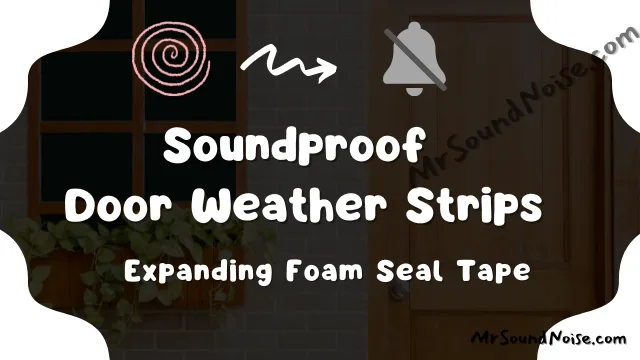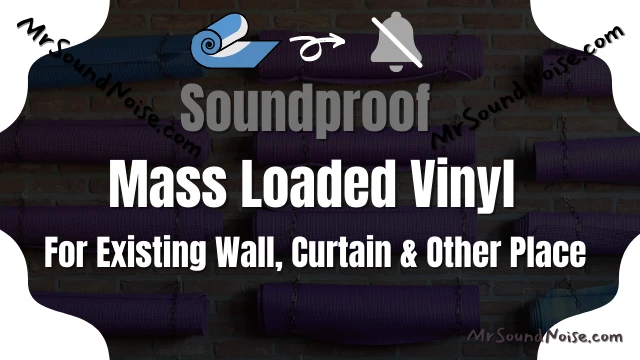
You don’t understand which one is best among three types of materials (cellulose vs Rockwool vs fiberglass) for soundproofing.
You don’t know the real difference (among the three of them). This is the reason why you don’t make a decision, which material that you should collect for soundproofing your area. Right!
Now, you are searching the internet for finding the best one but still, you don’t get the exact information!
I think you have come to the right place for finding the right soundproof accessories. Here, you will also get the actual difference. You will also get the information that you require most for acoustic implementation.
So continue reading and get the right data that you want.
There are different types of insulation processes available. First, you should know the actual definition of these acoustic elements.
Definition of Cellulose, Rockwool, and Fiberglass
What is Cellulose
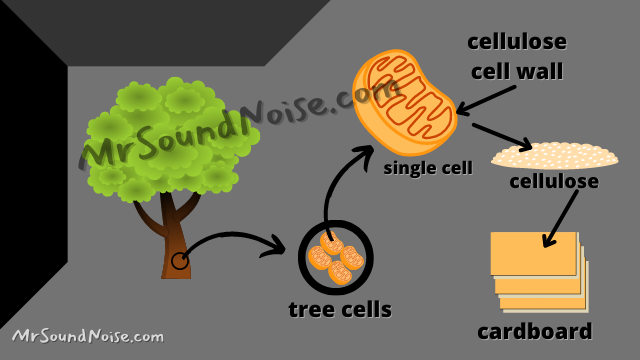
It is a plant fiber (organic material) that maintains the shape of the molecule of a plant. It is found in the wall of a plant cell. It is used for producing paper, cardboard, fiberboard, etc.
There are some notes about cellulose accessories. You should read it carefully.
Dry cellulose is used as organic insulation (noise/sound barrier) for different places. Hard and dry cellulose can reduce low-frequency noise. The R-value of cellulose is 3.2-3.8 (per inch).
After producing it, some is kept for producing cellulose panels. Some chemicals are also mixed during producing this type of panel.
This panel is like a solid hardboard panel. You can use it in the room wall and ceiling section (attic floor) for growing soundproofing.
Attic Insulation in the ceiling section is also important for creating a room more silent. For more details, you can read this article about wall soundproofing.
On the other hand, loose cellulose is stored with a packaging system. Loose-fill insulation is also used in noise-proofing issues. For applying it, you need to follow the blown-in method. Which is described below.
N.B: Wood or paper type of product contains cellulose which is used for the home appliance for soundproofing activities.
This material is used for reducing the ceiling noise.
What is Rockwool
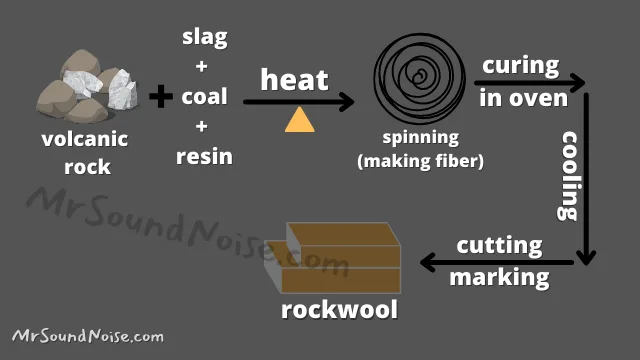
The other names of Rockwool are stone wool and mineral wool. You should know the manufacturing process of rock wool or how it is produced to know better about it.
Energy is transferred to volcanic stone and melted with steel slag and basalt. After heating these elements, fibers are created through the spinning section.
Then these fibers are moved to the curing process. After completing the curing process, these fibers are transferred through the cooling section. When this process is done, then these fabrics are called Rockwool.
Rockwool (mineral wool batts) has also the performance for sound insulation activities.
For soundproofing purposes, mineral wool is applied in various places. (source)
It has a porous nature and is ideal for thermal insulation. It is also recycled material. For these properties, it is used in different places. The R-value of Rockwool is 3.0-3.3 (per inch).
It is used in ceiling, wall cavity, electrical box, pipes, drywall, etc. You should install this wool according to the guidelines.
If the installation process is wrong, the total soundproofing setting may be ineffective. But I want to tell you that the implementation process is not a tough task. Just you need to follow the required steps.
For knowing more, you can read the article: does concrete absorb sound?
Now, I am talking about fiberglass which is very popular nowadays. So you should keep reading to know the important points of fiberglass.
What is Fiberglass
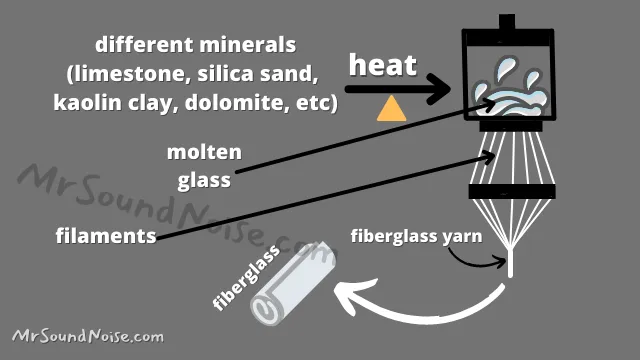
It is made from different minerals. Such as limestone, silica sand, dolomite, etc. After heating these ingredients, they turn into molten glass.
This molten glass is pushed through many little holes. This is the reason why filament fibers are created in that situation. Finally, fiber yarn is produced. It is called fiberglass which is also good for thermal insulation.
Overall, I want to say that it has the great capacity to soundproof any area. You can use it on the wall, ceiling, and floors too.
N.B: If you are interested in soundproofing a floor section, you should read all guidelines of the ceiling section. The main specialty of fiberglass is that it has the property of sound absorption. Because it is a soft material and lots of air holes are included in it. The R-value of fiberglass is 2.2-2.7 (per inch). You can use this fabric for reducing echo (reflective noise) in the internal room.
For reflection of the noise, you should not use fiberglass. Because the surface of this fiberglass is irregular. This is the reason why any sound wave can’t reflect on the surface of this fiber.
But don’t be upset, this fiber can absorb most of the sound that is used in the internal room. If you want to collect the best type of fiberglass insulation for soundproofing your room, you should check the information and guideline for the implementation of this fiber.
Now, I am discussing the main topic. I have already described three types of acoustic accessories. You may be confused about which one is better for you.
So you should continue reading if you want to get the information about the right acoustic accessory for you.
Cellulose vs Rockwool vs Fiberglass: Which is Better?
Now, I am giving some notes about these three types of acoustic elements. After reading the notes below, you may make a decision about which one is perfect for you.
But if you read the total post, you can also get a clear overview for selecting the right acoustic material.
Note 1: If you compare Rockwool with fiberglass, I want to tell you that Rockwool has a higher R-value than fiberglass.
Note 2: You need more budget to collect Rockwool while fiberglass needs less budget.
Note 3: Rock wool is more environmentally friendly than fiberglass.
Note 4: Cellulose has a higher R-value than fiberglass. It contains air holes which also help to absorb sound waves. On the other hand, fiberglass doesn’t contain air holes like cellulose.
Note 5: If you want to collect cellulose accessories, you may need a higher budget than another fiberglass. It may create dust during application or installation.
Note 6: Cellulose may decompose. On the other hand, fiberglass is not like cellulose in decomposing tissue.
Note 7: Cellulose can absorb more moisture than fiberglass.
There are also some characteristics of these materials according to budget, airflow, burning, and lasting capacity. Here, I am trying to share some information about these elements.
1. Compare Budget
You should plan a high budget if you want to implement Rockwool. On the other hand, fiberglass needs a low budget in comparison with Rockwool.
Cellulose also needs a higher budget in comparison with fiberglass. So you should prepare a budget and plan first.
Then you should think about which accessory you will collect for the implementation of your area. You should also check other accessories that you may need for the acoustic application.
If you really face a terrible noise problem, then I suggest you collect reliable accessories for soundproofing your house properly.
2. Air Flow
The hard cellulose panel has no air leakage. So this type of panel can also stop airflow. On the other hand, loose cellulose contains air gaps (air pockets).
Besides, Rockwool and fiberglass also contain a small number of air gaps. This is why fiberglass and Rockwool can reduce airflow but can’t stop the airflow fully.
Air gaps also help to reduce airborne noise (sound). For this type of characteristics of fiberglass and Rockwool, they are more capable of absorbing sound frequency.
3. Flammable or Not
Cellulose contains ammonium sulfate and borate which is a fire obstacle. But it can be flammable in excessive heat.
Rockwool can bear fire up to 1000 degrees celsius. So this insulated material can give you a better facility for both fire protection and soundproofing.
This wool is made from rock. This is why it is not easily burned at low temperatures. But above 1000 degrees celsius, Rockwool may be flammable.
Fiberglass can bear fire up to (540-600) degrees celsius. The filament of this material is made from glass. This is the reason why it is not melted at low temperatures.
4. Lasting Capacity
Cellulose is a long-lasting element because, during production, some chemicals are melted in this fiber. After using it for a long time, it may get wet. This is why it may decay slowly.
Rockwool is inorganic and is made from stone. This is why it doesn’t decay if you set it up in an accurate way. After using it for a long time, this wool doesn’t rot or destroy.
This is the best facility for using it in soundproofing activities. Fiberglass does not also decay or rot.
Installation System for Soundproofing
1. Installation of Cellulose
There are two types of installation processes of this material. They are:
a. Setup of Cellulose Panel
This panel looks like cardboard. You can use it in the wall and ceiling section. This system is called butts. Most people like this type of installation because it is super easy.
You may face a problem, when you will set up these panels around the electrical board, pipes, etc. After applying these panels, there may be some small gaps. This is the reason why you may not find better results by applying the butts system.
b. Apply Loose-Fill Cellulose by the Blown-in Method
Though this system is tough, the result of the blown-in method is better than the butts system. You need a spray machine for spreading loose cellulose.
So, you need professional people to apply this method. You can fill all corners by applying this method, as your wish. This is the reason why there is not any gap in your applied area. As a result, you will get better soundproofing results.
2. Rockwool Installation
Rockwool is a foam-type soft panel. You can attach it to the interior or exterior walls like other foam panels. Inside the ceiling frame, you can place these panels in an easy way for keeping your room more soundproof.
3. Fiberglass Installation
The fiberglass panel is also soft like Rockwool. The setup process is the same as Rockwool.
My Viewpoint
In overall viewpoint, I want to tell you that you should have a clear concept about these three types of acoustic elements.
It will be better if you have clear data about sound insulation and absorption. If you want to reduce the sound transmission from your home and other places, you need to select the right acoustic accessory for getting a better result.
This is the reason why you need to know the important information about them. After reading the total article, you will understand the specific difference (among cellulose, Rockwool, and fiberglass).
Fiberglass batts insulation is also applied in the ceiling and wall for better performance. In this article, I have shared a small brief of the production process of these three acoustic materials.
I have also tried to understand the production process with an image diagram so that you can easily understand the total production overview.
Here, I have also tried to share the comparison among these three types of materials. After reading this comparison, you can understand the preferred acoustic material for you.
So finally, I want to say that you may also require other reliable acoustic materials if you want to make a room silent.
Here are given some questions with answers in the FAQ section. You should read these questions for the required information in a short time.
FAQ: Cellulose vs Rockwool vs Fiberglass
Is the Setup of Cellulose Insulation Good for Soundproofing?
It is a fiber that is collected from plants. There are two types of processes for the implementation of cellulose for noise reduction.
One is butts and the other is blown in the method. If you follow the second method (blown-in), you can fill all the gaps in your selected area. This is the reason why you can also get a better result by applying this method.
What Insulated Element is Best for Soundproofing?
Cellulose, Rockwool, and fiberglass are preferable for reducing sound waves. You should apply these acoustic elements to your home condition.
Besides, you should also read the guidelines, before installing any acoustic material. I prefer Rockwool and other reliable acoustic materials.
Does Standard Fiberglass Insulation Absorb or Reduce Noise Levels?
It can absorb some noise and it can also reduce some Impact (sounds) noises.
How Strong are Cellulose Materials (Fibers)?
There are two types of this fiber material. One is loose-fill cellulose and the other is a hard cellulose panel. The hard panel is stronger than loose cellulose. Because this hard panel is like a cardboard panel.
Is Cellulose Fiber a Natural Material?
Yes, it is a natural material because it is collected from tree fiber.


